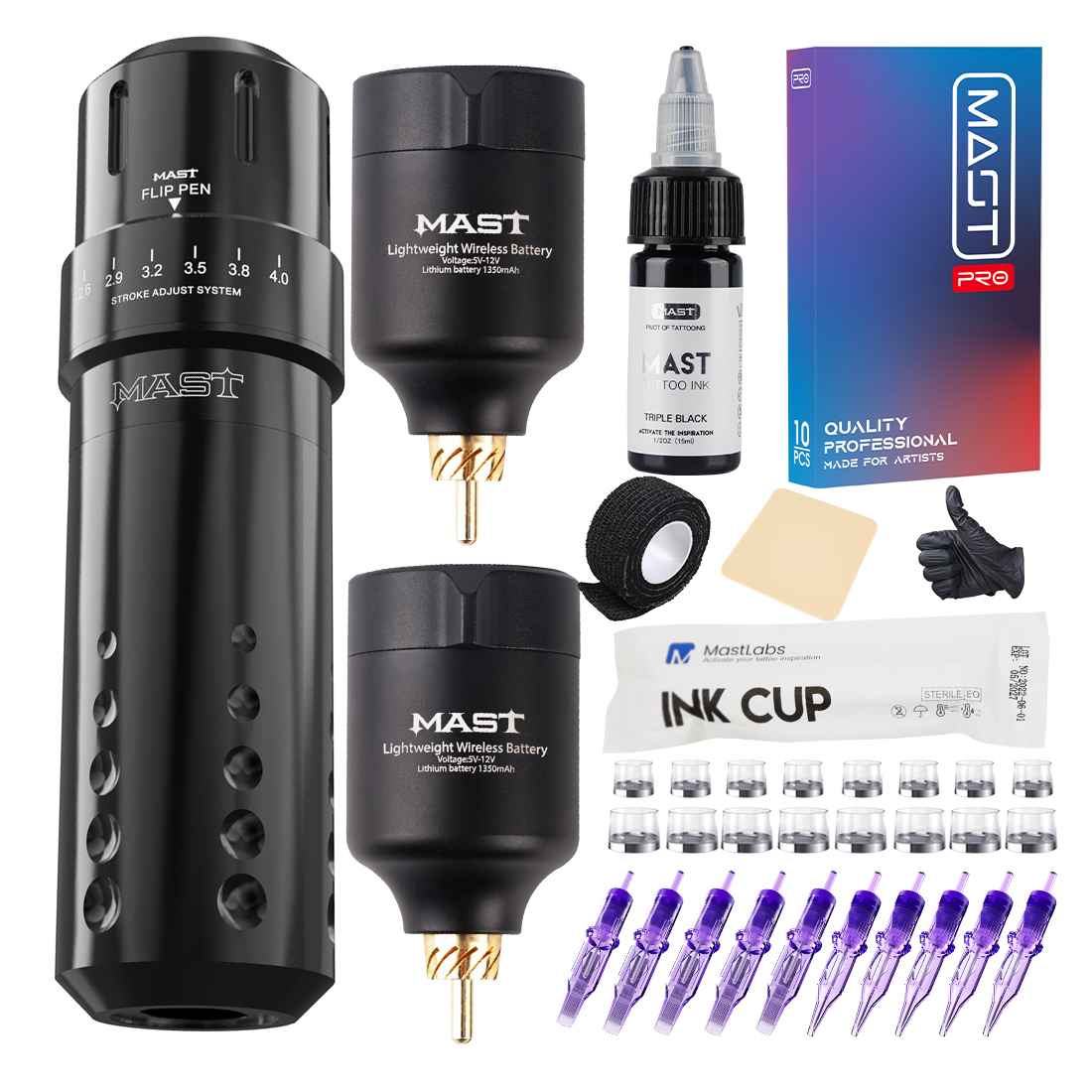Has this question ever bothered you, “Why do tattoo artists wear black gloves, turning their hands into enigmatic shadows in the vibrant world of body art?”
It’s common to see tattoo artists sporting black nitrile or latex gloves while working on clients. The striking black gloves have become an iconic part of the tattoo artist’s image.
It’s a puzzle that sparks curiosity, leaving many to speculate on the reason behind this shared fashion statement. As the tattoo needle dances on your skin, you might find yourself pondering the significance of those dark-hued gloves.
But beyond aesthetics and style, there are important practical reasons artists wear disposable gloves during tattooing.
In this article, we’ll embark on a journey to demystify the enigma of black gloves in the tattooing realm.
Uncover the hidden benefits and discover why these artists don’t just wear gloves—they wear black gloves with purpose and passion!
Why Do Tattoo Artists Wear Black Gloves
Let’s go over the why tattoo artists wear black gloves;
1. Infection Control
The primary reason tattoo artists wear gloves is for infection control and preventing cross-contamination.
Tattooing involves a lot of contact with bodily fluids like blood and plasma. It also creates open wounds in the client’s skin.
This makes transmission of bloodborne pathogens like HIV or hepatitis a major risk if safety precautions aren’t followed.
Wearing fresh gloves for each new client and new tattoo helps prevent contagious diseases from spreading. The gloves form a protective barrier between artist and client.
2. Sanitation Procedures
Reputable tattoo shops adhere to strict sanitation practices. This includes sterilizing equipment, using single-use needles and ink caps, and discarding used gloves after every tattoo.
Always confirm a shop’s sanitation protocols before getting work done. The artist should open sealed packages in front of you and put on new gloves. Used gloves must go directly in a hazardous waste bin – never be reused.
Also Read: Why Don’t Tattoo Artists Use Numbing Creams [9 Strong Reasons + Safer Alternatives]
3.Skin Irritants
The chemicals in tattoo inks, disinfectants, soaps, and ointments can irritate skin and even cause allergic reactions.
Gloves limit the artist’s repeated exposure to these harsh compounds as they tattoo multiple clients every day. The gloves safeguard the artist’s skin health over their career.
4. Stains
Gloves protect artists’ hands from being permanently stained by tattoo inks. Inks, especially darker shades, will leave lasting pigment behind on the skin.
The staining worsens over time as artists do more tattoos. The black gloves act as a shield against stubborn ink stains.
5.Traction
Latex and nitrile gloves allow artists to maintain a good grip on tattoo machines and equipment.
The gloves’ traction gives them control for precise artistic movements. The gloves’ tight fit also lets artists better sense pressure and depth while working on clients’ skin.
Also Read: Why Do They Ask If You Have Tattoos Before Surgery?
6. Artist Comfort
The smooth interior lining of gloves keeps artists’ hands cool and sweat-free during long sessions.
Friction from equipment can cause callouses, cuts, and abrasions on unprotected skin.
Gloves defend against these occupational hazards. Their use makes the repetitive motions of tattooing less taxing.
7. Client Comfort
Clients may feel more comfortable knowing the artist’s hands are fully covered by clean gloves. It signals professionalism and attentiveness to health protocols.
Even if artists scrubbed well, clients may not want ungloved hands touching open wounds. Gloves build clients’ trust and ease potential anxiety.
8. Efficient Cleanup
At the end of a tattoo session, taking off the gloves eliminates much mess and hassle. There’s no need to scrub ink, blood, or ointment off the artist’s hands.
They can quickly strip the soiled gloves and put on a fresh pair for the next client. It makes transitions between sessions smooth and efficient.
Also Read: Can a Veterinarian Have Tattoos? Here’s the Honest Truth
9.Distinct Image
The black gloves complete the tattoo artist’s edgy, iconic look. Along with tattoo machines and ink bottles, the gloves visually convey the artists’ identity and profession.
Gloved artists stand out in most settings outside traditional tattoo shops. The gloves are a declaration of their skills, experience level, and command of safety protocols.
Why Are Tattoo Gloves Usually Black?
Tattoo artists overwhelmingly choose disposable gloves in classic black, for several key reasons:
1. Tradition
Black gloves have historically dominated among tattoo artists. Their stark appearance against artists’ skin became an instantly recognizable symbol of tattoo culture. Artists continue donning black gloves both for nostalgic ties to tradition and practical reasons.
2. Visibility
Artists need to closely monitor glove condition as they work. Black gloves show tears, stains, or thinning fabric more clearly during the tattoo process. It allows artists to spot potential contamination risks. Light colored gloves would conceal developing holes or leaks.
3. Appearance
Black nicely complements artists’ typical attire and inked skin. For many artists, image matters, so going with black gloves fits their aesthetic. But function still trumps form – artists would give up black gloves if another color proved more practical.
4. Availability
Black is the most readily available color for disposable glove options. Specialty colors usually come with a higher price tag. Sticking with basic black nitrile or vinyl allows studios to purchase quality gloves affordably in bulk.
5. Client Expectations
Clients anticipate seeing artists in classic black gloves. Departing from expectations might seem odd or dubious to some. Artists want clients assured they follow norms and prioritize hygiene. Black gloves offer familiarity and confidence.
However, white or other colors of gloves would likely serve fine functionally. The convention emerged from tradition, supply logistics, and image, more than necessity.
Several newer glove types use black color-coding to designate materials like nitrile. So black’s dominance stems largely from precedent and perception. But artists show no signs of abandoning trusted black gloves.
Unorthodox Tattoo Glove Uses
Once tattoo sessions finish, artists discard used gloves as infectious waste. However, some clients or fellow artists get creative repurposing the iconic black gloves:
1. Tattoo Photography
Photographers use gloves as props when capturing a new tattoo. Placing a tattooed limb on black gloves adds style, conveys the context, and provides a sterile backdrop. The gloves evoke the tattoo experience.
2. Tattoo Aftercare
Clients may wear leftover artist gloves while caring for a new tattoo. This prevents contamination when applying ointments or bandages. The gloves can aid healing for finger, hand, or foot tattoos.
3. Fashion Statement
Gloves from renowned artists become coveted fashion accessories. Collectors and fans wear the gloves as a tribute to respected artists. The item’s rarity and connection to admired artists drives the appeal.
4. Memorabilia
Clients save date-inscribed gloves from milestone tattoo sessions as souvenirs. Paired with photos, the gloves encapsulate memories getting meaningful tattoos.
5. Costume Component
Gloves get incorporated into punk, goth, and rocker costumes. They complete looks aiming for edgy authenticity. The gloves signal both rebellion and mysteriously concealed hands.
6. Medical Care
Those with medical training reuse gloves for basic first aid in a pinch. But tattoos gloves provide far less protection than sterile medical gloves. Only use them absent better alternatives.
However, repurposing tattoo gloves is generally risky. Used gloves contain hazardous contaminants and should get discarded properly.
Unorthodox glove uses also promote unsafe practices if emulated. But in controlled circumstances, artists’ gloves find second lives beyond the studio. The gloves’ iconic imagery provokes artistic inspiration.
Proper Tattoo Glove Handling
While essential for safety and hygiene, gloves themselves can transmit disease if misused. Artists must rigorously follow protocols for glove handling:
- Inspect packaging – Never use compromised or opened packages.
- Open in front of client – Builds trust and transparency.
- Wash hands first – Don hands clean before gloving.
- Pull on carefully – Avoid tearing fragile material.
- Check for defects – Ensure no holes or thin spots.
- Change between clients – No exceptions to this rule.
- Avoid contact once removed – Prevent cross-contamination.
- Only touch work surfaces – Don’t touch face or surfaces like phones.
- Discard immediately in waste bin – Never reuse or repurpose.
These strict standards maintain the gloves’ integrity in blocking contamination. Tattoo artists hold public health in their gloved hands. upholds principles of safety and hygiene.
Conclusion
In this article, we’ve seen the question, “Why do tattoo artists wear black gloves?” We’ve seen that the black nitrile or latex gloves worn by tattoo artists serve crucial sanitary and protective purposes.
Their use reflects a conscientious, skilled artist who prioritizes client wellbeing and safety.
While initially donned for practical reasons, the gloves soon became an iconic symbol of tattoo culture.
Yet behind their image-conscious choice lies serious consideration of contamination risks.
Tattoo gloves ultimately represent an artist’s meticulous dedication to their craft.
FAQ About Tattoo Artist Gloves
Should tattoo artists double glove for extra protection?
In most cases double gloving is unnecessary and could diminish artists’ precision and tactile feedback. As long as artists change gloves meticulously between clients, single gloves offer sufficient protection. However, double gloving could benefit artists with skin conditions or known latex allergies.
Do artists need to wear gloves when just setting up equipment?
Yes, artists should glove up any time they contact tattooing tools, surfaces, and materials. Even setting up carries risks of cross-contamination. Artists ideally put on fresh gloves right before a client arrives and removes them promptly after finishing.
Is it ok for artists to wear gloves outside the studio?
Artists should remove gloves immediately after finishing a tattoo. Never wear used studio gloves in public, even briefly running errands. However, wearing clean unused gloves as a fashion statement poses no issue as long as artists discard them soon after.
How often do artists need to change gloves during long sessions?
During marathon sessions, artists should swap out gloves every 3-4 hours. Gloves degrade with prolonged wear, raising contamination risks. Regular glove changes every few hours ensures persistent protection even during extensive tattoos.
Should clients provide their own gloves for getting tattooed?
No, reputable studios provide high-quality disposable gloves certified for medical use. Artists know which glove materials and brands suit tattooing. Clients wearing their own gloves could actually undermine safety if the gloves are non-sterile or introduced into the studio improperly.






